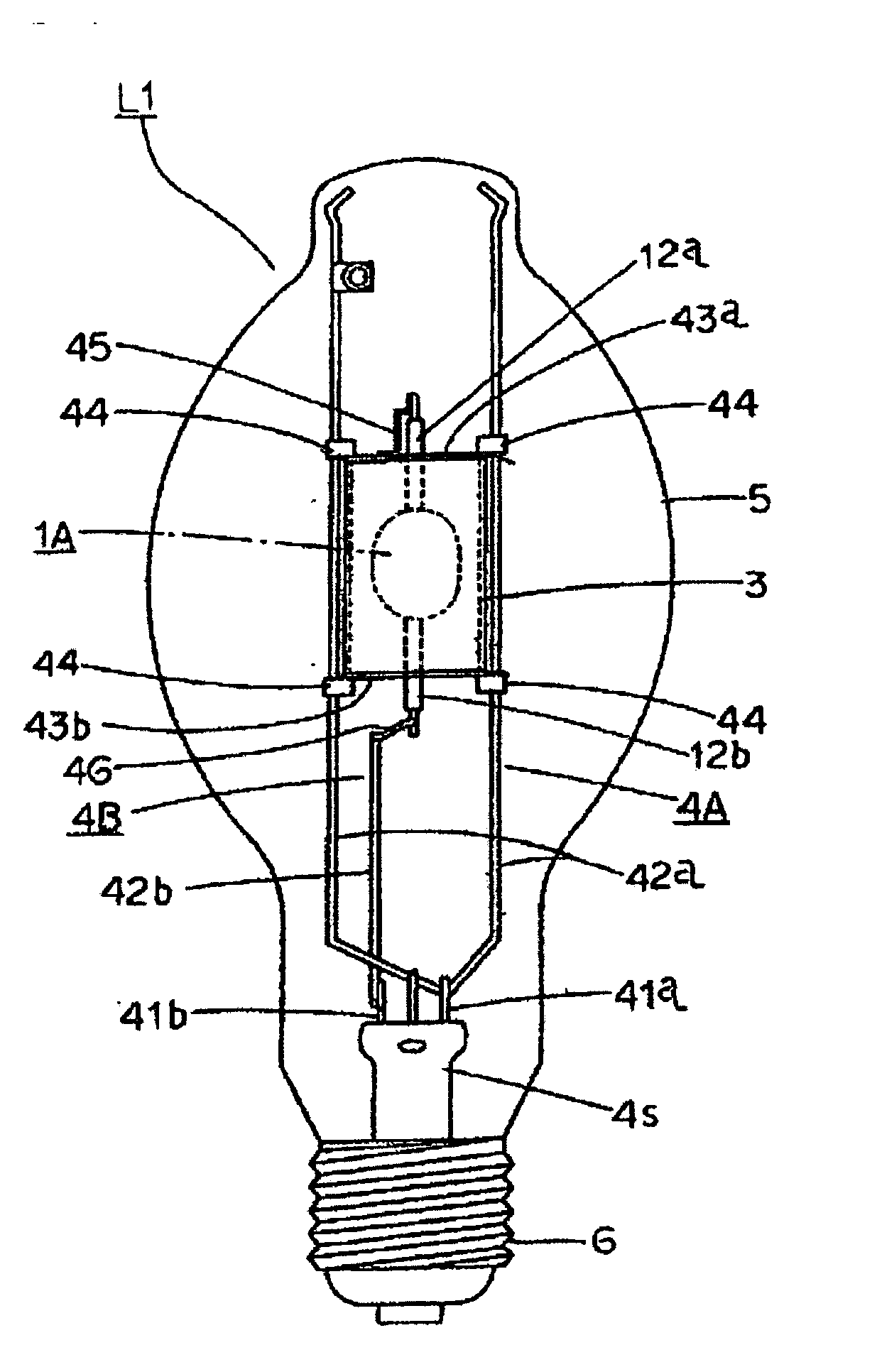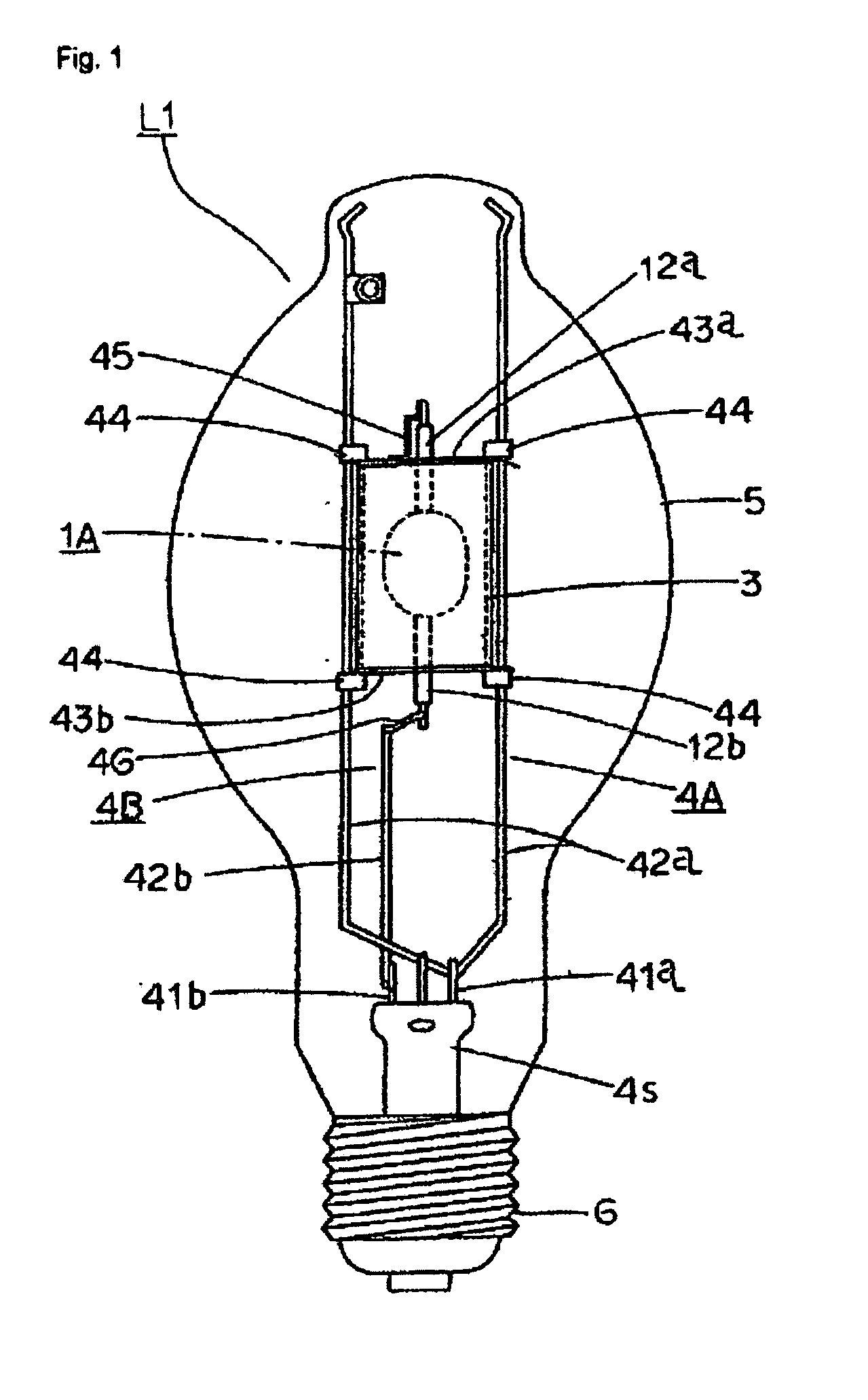High-intensity discharge lamp and related lighting device
a discharge lamp and high-intensity technology, which is applied in the direction of electric discharge lamps, gas-filled discharge tubes, solid cathodes, etc., can solve the problems of poor color rendition and life, poor efficiency, and difficulty in developing single discharge lamps with excellent values
- Summary
- Abstract
- Description
- Claims
- Application Information
AI Technical Summary
Problems solved by technology
Method used
Image
Examples
embodiment 1
[0189] The power rating of the lamp was about 250 W, the arc tube 1A made of translucent alumina ceramic had a total length of approximately 60 mm, with an external diameter of bulging section 11 being approximately 16.6 mm, an internal diameter of approximately 14.0 mm and an internal volume of about 1.5 cc, and a tube wall loading of 28 watts / cm.sup.2. In Embodiment 1, the external diameter of small diameter tubular sections 12a, 12b is approximately 3.0 mm, the internal diameter is approximately 1.2 mm, with the chamber 1 of this arc tube 1A being almost entirely surrounded by inner shroud tube 3.
[0190] Electrodes 2A, 2B have electrode shafts 21 of tungsten with an external diameter of approximately 0.6 mm and a length of approximately 8 mm, with the electrode coil section 22 wound from tungsten wire with an external diameter of approximately 0.2 mm, at a pitch density of approximately three turns, the distance of the gap between the two electrodes being approximately 15 mm.
[0191...
embodiment 2
[0199] The power rating of the lamp was 250 W, the rated life was 12,000 hours, the arc tube 1A was made of translucent alumina ceramic having a total length of approximately 60 mm, with an external diameter of bulging section 11 of approximately 16.6 mm, an internal diameter approximately 14.0 mm and internal volume of 1.5 cc. In Embodiment 2, the external diameter of small diameter tubular sections 12a, 12b is approximately 3.0 mm, the internal diameter is approximately 1.2 mm, the total length is approximately 20 mm, and the chamber 1 of the arc tube 1A is almost entirely surrounded by inner shroud tube 6.
[0200] Electrodes 2A, 2B have electrode shafts 21 made of tungsten with an external diameter of approximately 0.6 mm and a length of approximately 8 mm. In Embodiment 2, electrode coil section 22 is wound from tungsten wire with an external diameter of approximately 0.2 mm, at a pitch density of approximately three turns, the distance of the gap between the two electrodes being ...
embodiment 1 embodiment 2 embodiment 3
1 TABLE 1 Embodiment 1 Embodiment 2 Embodiment 3 Type of arc tube Integral type Shrink-fit type Integral type Halide used Na, TlI, InI, TmI.sub.3 Na, TlI, InI, Na, TlI, InI, (% by weight) (30:15:5:50 wt %) TmI.sub.3 TmI.sub.3 (30:15:5:50 wt %) (30:15:5:50 wt %) Lighting Vert. Horiz. Vert. Horiz. Vert. Horiz. direction BU BH BU BH BU BH Lamp voltage 102.6 104.9 100.5 109.3 101.9 105 (V) Lamp wattage 246 243 247 244 400 3.97 (W) Total lumen 26986 26074 26009 24623 43281 40994 (Lm) Efficacy (Lm / W) 110 107 105 101 108 103 CCT(K) 4188 4093 4276 4119 4238 4137 Chromacity 0.0026 0.0013 0.0072 0.0049 0.0028 0.0009 (d.u.v.) Color rendition 82.1 84.6 80.1 85.1 81.5 82.2 Ra 1 Total Lm 912 1386 2287 CCR (K) 95 157 101 Chromacity 0.0013 0.0023 0.0019 d.u.v. Color 2.5 5 0.7 rendition Ra 2 MTm / M 0.50 (50%) 0.50 (50%) 0.50 (50%) (MTm + MTl) / M 0.65 (65%) 0.65 (65%) 0.65 (65%) (MTm + MTl + MIn) / M 0.70 (70%) 0.70 (70%) 0.70 (70%) MIn / M 0.05 (5%) 0.05 (5%) 0.05 (5%) MIn / 0.08 (8%) 0.08 (8%) 0.08 (8%) (...
PUM
 Login to View More
Login to View More Abstract
Description
Claims
Application Information
 Login to View More
Login to View More - R&D
- Intellectual Property
- Life Sciences
- Materials
- Tech Scout
- Unparalleled Data Quality
- Higher Quality Content
- 60% Fewer Hallucinations
Browse by: Latest US Patents, China's latest patents, Technical Efficacy Thesaurus, Application Domain, Technology Topic, Popular Technical Reports.
© 2025 PatSnap. All rights reserved.Legal|Privacy policy|Modern Slavery Act Transparency Statement|Sitemap|About US| Contact US: help@patsnap.com



